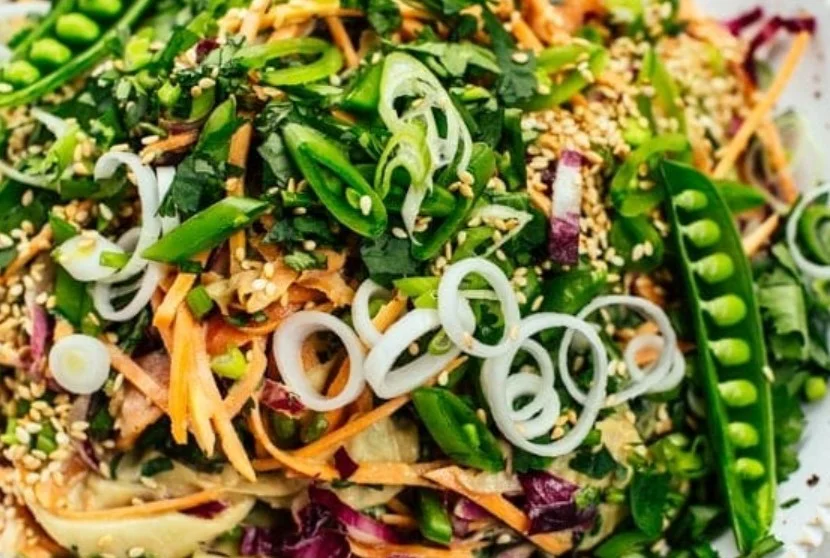When most people think of potatoes, they picture something hot, crispy, or creamy. But did you know you can enjoy potatoes raw too? I’ve experimented with a few raw potato recipe, and I was surprised at how flavorful and satisfying they can be—especially when paired with the right ingredients.

In this post, I’m sharing some easy and refreshing raw food potato ideas that are perfect if you’re into clean eating, raw food, or just love trying something different. No stove, no oven—just simple, natural goodness.
How To Make Raw Food Potato Recipe
🥔 Recipe Overview
- Preparation Time: 10 minutes
- Cooking Time: 0 minutes (raw recipe)
- Total Time: 10 minutes
- Calories: 150 kcal (per serving)
- Cuisine: Raw Vegan / Plant-Based
- Yield: 2 servings
🔧 Equipment Needed
Here’s a simple Equipment Needed section tailored for a raw food potato recipe:
- Vegetable peeler
- Sharp knife or mandoline slicer
- Cutting board
- Mixing bowl
- Spiralizer (optional – for raw potato noodles)
- Grater or food processor (optional – for shredded potato)
🥕 Ingredients
Here’s a sample Ingredients list for a basic raw potato salad one of the most popular raw food potato recipe:
- 2 medium white or red potatoes (peeled and thinly sliced or spiralized)
- 1 small carrot (grated)
- 1 small cucumber (sliced thin)
- 1 tablespoon lemon juice
- 1 tablespoon olive oil (or cold-pressed oil of choice)
- 1 teaspoon apple cider vinegar
- 1/2 teaspoon sea salt (or to taste)
- 1/4 teaspoon black pepper
- 1 tablespoon fresh parsley or dill (chopped)
- 1 small clove garlic (minced – optional)
📝 Instructions: Step-by-Step
Absolutely! Here’s a detailed step-by-step version of the instructions for raw food potato recipe:
- Step 1: Peel the potatoes
I start by peeling two medium potatoes. You can use red, white, or even Yukon Gold for a slightly sweeter taste. - Step 2: Slice or shred the potatoes
Using a sharp knife, mandoline, or spiralizer, I slice the potatoes into thin ribbons or noodles. If I want a shredded texture, I go for a grater or food processor. - Step 3: Soak the potatoes (optional but worth it)
I place the raw potato slices in a bowl of cold water with a teaspoon of lemon juice. This helps reduce any bitterness and makes them crispier. I let them soak for about 10–15 minutes. - Step 4: Drain and dry
After soaking, I drain the potatoes well and gently pat them dry with a clean kitchen towel. This step keeps the salad from getting watery. - Step 5: Prep the veggies
I grate one small carrot and thinly slice a cucumber. These add crunch, color, and freshness. - Step 6: Mix the base
In a large mixing bowl, I toss the potatoes, carrot, and cucumber together. - Step 7: Make the dressing
In a smaller bowl, I whisk together 1 tablespoon of lemon juice, 1 tablespoon of olive oil, 1 teaspoon of apple cider vinegar, 1/2 teaspoon of sea salt, 1/4 teaspoon of black pepper, and 1 minced garlic clove (optional). - Step 8: Dress the salad
I pour the dressing over the veggies and gently toss everything together until it’s evenly coated. - Step 9: Add herbs
For a burst of flavor, I sprinkle in a tablespoon of chopped fresh parsley or dill. - Step 10: Chill and serve
I like to let the salad chill in the fridge for 10–15 minutes. It helps the flavors meld together beautifully. Then I serve it fresh and crisp!
🍽️ Serving Suggestions
Here are some easy and creative Serving Suggestions for your raw potato salad (or other raw potato dishes):
- As a light lunch: I like to enjoy it on its own for a quick, refreshing midday meal—especially on warm days.
- With raw wraps: Spoon the salad into large lettuce leaves or collard greens to make raw veggie wraps.
- On a raw platter: Pair it with sliced avocado, cherry tomatoes, raw hummus, and sprouts for a beautiful raw snack board.
- Topped with seeds or nuts: I sometimes add sunflower seeds, chopped walnuts, or hemp seeds for a bit of crunch and protein.
- Next to raw crackers: Serve it with dehydrated raw crackers or flaxseed crisps for a more filling meal.
- With a drizzle of extra dressing: Right before serving, I like to add an extra splash of lemon juice or a sprinkle of nutritional yeast for added flavor.
🥗 Nutrition Facts (Per Serving)
Here’s a sample Nutrition Facts Per Serving for a basic raw food potato recipe (based on 2 servings). You can adjust this depending on your exact ingredients:
- Calories: 150 kcal
- Carbohydrates: 25g
- Protein: 2g
- Fat: 5g
- Saturated Fat: 0.5g
- Fiber: 3g
- Sugar: 2g
- Sodium: 300mg
- Potassium: 620mg
- Vitamin C: 20% DV
- Iron: 6% DV
How to Store
To store raw food potato recipe for recipes, keep them in a cool, dark, and well-ventilated place, like a pantry or cupboard, away from sunlight and heat.
Avoid storing them in plastic bags or the fridge, as moisture and cold can spoil their texture and flavor. Make sure they stay dry and check regularly for any sprouting or soft spots to keep them fresh longer.
Note:
When using raw potatoes in recipes, make sure to choose firm, fresh potatoes without green spots or sprouts. Peel and rinse them well to remove any dirt. Some raw potato dishes may benefit from soaking the peeled potatoes in cold water briefly to reduce starch and prevent browning.
Always handle raw potatoes carefully to avoid bitterness caused by any green areas. Cooking raw potatoes thoroughly is important unless the recipe specifically calls for eating them raw, like in certain salads or slaws.
FAQs: How to Store Raw Potatoes for Recipe
Can I store potatoes in the refrigerator?
It’s best not to. The cold turns the starch into sugar, causing a sweet taste and gritty texture.
How long can raw potatoes last when stored properly?
Usually 3 to 5 weeks if kept in a cool, dark, and dry place.
Should I wash potatoes before storing them?
No, wash them only right before cooking. Excess moisture promotes rot during storage.
Why do potatoes turn green?
Exposure to light causes potatoes to produce chlorophyll and solanine, which can be bitter and toxic if eaten in large amounts.
Can I store potatoes with onions?
It’s better to store them separately. Onions and potatoes release gases that can cause each other to spoil faster.
What should I do if my potatoes sprout?
You can cut off the sprouts and still use the potato if it’s firm and not green or shriveled.
Conclusion
Storing raw food potato recipe properly is crucial to preserving their quality and taste. Keep them in a cool, dark, and dry place with good airflow to prevent sprouting and spoilage.
Avoid exposing potatoes to light or moisture, which can cause them to turn green or rot. Refrigeration isn’t recommended, as cold temperatures change their texture and flavor.
By checking your potatoes regularly and removing any that show signs of damage, you can extend their shelf life. With these simple storage tips, your raw potatoes will stay fresh and ready for all your favorite recipes.
Raw Food Potato Recipe
Ingredients
Equipment
Method
- I start by peeling two medium potatoes. You can use red, white, or even Yukon Gold for a slightly sweeter taste.
- Using a sharp knife, mandoline, or spiralizer, I slice the potatoes into thin ribbons or noodles. If I want a shredded texture, I go for a grater or food processor.
- I place the raw potato slices in a bowl of cold water with a teaspoon of lemon juice. This helps reduce any bitterness and makes them crispier. I let them soak for about 10–15 minutes.
- After soaking, I drain the potatoes well and gently pat them dry with a clean kitchen towel. This step keeps the salad from getting watery.
- I grate one small carrot and thinly slice a cucumber. These add crunch, color, and freshness.
- In a large mixing bowl, I toss the potatoes, carrot, and cucumber together.
- In a smaller bowl, I whisk together 1 tablespoon of lemon juice, 1 tablespoon of olive oil, 1 teaspoon of apple cider vinegar, 1/2 teaspoon of sea salt, 1/4 teaspoon of black pepper, and 1 minced garlic clove (optional).
- I pour the dressing over the veggies and gently toss everything together until it’s evenly coated.
- For a burst of flavor, I sprinkle in a tablespoon of chopped fresh parsley or dill.
- I like to let the salad chill in the fridge for 10–15 minutes. It helps the flavors meld together beautifully. Then I serve it fresh and crisp!
